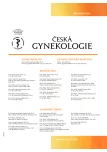Prophylactic bilateral iliac artery balloon occlusion during cesarean section in Jehova´s Witnesses patient
Authors:
Milan Kudela 1,3
; M. Černá 2; E. Hostinská 1; K. Huml 1; Š. Grofová 4; R. Pilka 1
Authors‘ workplace:
Porodnicko-gynekologická klinika LF UP a FN, Olomouc, přednosta prof. MUDr. R. Pilka, Ph. D.
1; Radiologická klinika LF UP a FN, Olomouc, přednosta prof. MUDr. M. Heřman, Ph. D.
2; Ústav zdravotnických věd FHS UTB, Zlín, ředitelka Mgr. P. Juřeníková, Ph. D.
3; Gynekologicko-porodnické oddělení, Nemocnice Přerov, SMN, a. s., primář MUDr. V. Boháč
4
Published in:
Ceska Gynekol 2019; 84(5): 337-340
Category:
Case Report
Overview
Objective: To describe a case report with prophylactic bilateral iliac artery balloon occlusion during cesarean section in Jehova´s Witnesses patient.
Design: Case report.
Setting: Department of Obstetrics and Gynecology, University Hospital, Olomouc; Department of Radiology, University Hospital, Olomouc; Department of Health Care Sciencies, Bata University, Zlín.
Case report: We describe case report with prophylactic bilateral iliac artery balloon occlusion during cesarean section in Jehova´s Witnesses patient in attempt to decrease the risk of heavy peroperative bleeding. Twenty eight years old primigravida underwent prophylactic internal iliac artery balloon catheterization with interventional radiology preoperatively. Two 6-Fr balloon catheters transfemorally bilaterally up to internal iliac artery with position a “cross over“ were introduced, according to Seldinger’s standard technique. The procedure was without complications, estimated blood loss was 500 ml.
Conclusion: Prophylactic placement of intravascular balloon catheters is a feasible treatment for Jehova´s Witnesses patients in efforts to decrease the risk of heavy bleeding during cesarean section.
Keywords:
balloon catheter – Jehova´s Witnesses
Sources
1. Bishop, S., Butler, K., Monaghan, S., et al. Multiple complications following the use of prophylactic internal iliac artery balloon catheterisation in a patient with placenta percreta. Int J Obstet Anesth, 2011, 20(1), p. 70–73.
2. Broekman, EA., Versteeg, H., Vos, LD., et al. Temporary balloon occlusion of the internal iliac arteries to prevent massive hemorrhage during cesarean delivery among patients with placenta previa. Int J Gynaecol Obstet, 2015, 128(2), p. 118–121.
3. Carnevale, FC., Kondo, MM., de Oliveira Sousa, W. Jr., et al. Perioperative temporary occlusion of the internal iliac arteries as prophylaxis in cesarean section at risk of hemorrhage in placenta accreta. Cardiovasc Intervent Radiol, 2011, 34(4), p. 758–764.
4. Cordonnier, C., Ha-Vien, DE., Depret, S., et al. Foetal growth restriction in the next pregnancy after uterine artery embolisation for post-partum haemorrhage. Eur J Obstet Gynecol Reprod Biol, 2002, 103(2), p. 183–184.
5. Doumouchtsis, SK., Nikolopoulos, K., Talaulikar, V., et al. Menstrual and fertility outcomes following the surgical management of postpartum haemorrhage: a systematic review. BJOG, 2014, 121(4), p. 382–388.
6. Dumousset, E., Chabrot, P., Rabischong, B., et al. Preoperative uterine artery embolization (PUAE) before uterine fibroid myomectomy. Cardiovasc Intervent Radiol, 2008, 31(3), p. 514–520.
7. Edwards, WS., Salter, PP. Jr., Carnaggio, VA. Intraluminal aortic occlusion as a possible mechanism for controlling massive intra-abdominal hemorrhage. Surg Forum, 1953, 4, p. 496–499.
8. Hughes, CW. Use of an intra-aortic balloon catheter tamponade for controlling intra-abdominal hemorrhage in man. Surgery, 1954, 36(1), p. 65–68.
9. Kai, K., Hamada, T., Yuge, A., et al. Estimating the radiation dose to the fetus in prophylactic internal iliac artery balloon occlusion: three cases. Case Rep Obstet Gynecol, 2015, 2015, p. 170343.
10. Kidney, DD., Nguyen, AM., Ahdoot, D., et al. Prophylactic perioperative hypogastric artery balloon occlusion in abnormal placentation. AJR Am J Roentgenol, 2001, 176(6), p. 1521–1524.
11. Ojala, K., Perala, J., Kariniemi, J., et al. Arterial embolization and prophylactic catheterization for the treatment for severe obstetric hemorrhage. Acta Obstet Gynecol Scand, 2005, 84(11), p. 1075–1080.
12. Poujade, O., Ceccaldi, PF., Davitian, C., et al. Uterine necrosis following pelvic arterial embolization for post-partum hemorrhage: review of the literature. Eur J Obstet Gynecol Reprod Biol, 2013, 170(2), p. 309–314.
13. Ringnes, HK., Hegstad, H. Refusal of medical blood transfusions among Jehovah‘s Witnesses: emotion regulation of the dissonance of saving and sacrificing life. J Relig Health, 2016, 55(5), p. 1672–1687.
14. Salazar, GM., Petrozza, JC., Walker, TG. Transcatheter endovascular techniques for management of obstetrical and gynecologic emergencies. Tech Vasc Interv Radiol, 2009, 12(2), p. 139–147.
15. Santoso, JT., Saunders, BA., Grosshart, K. Massive blood loss and transfusion in obstetrics and gynecology. Obstet Gynecol Surv, 2005, 60(12), p. 827–837.
16. Sentilhes, L., Kayem, G., Ambroselli, C., et al. Fertility and pregnancy outcomes following conservative treatment for placenta accreta. Hum Reprod, 2010, 25(11), p. 2803–2810.
17. Tan, CH., Tay, KH., Sheah, K., et al. Perioperative endovascular internal iliac artery occlusion balloon placement in management of placenta accreta. AJR Am J Roentgenol, 2007, 189(5), p. 1158–1163.
18. Yorozu, T. [Jehovah‘s Witness patients]. Masui, 2010, 59(9), p. 1149–1152.
Labels
Paediatric gynaecology Gynaecology and obstetrics Reproduction medicineArticle was published in
Czech Gynaecology

2019 Issue 5
Most read in this issue
- Syndrome Mayer-Rokitansky-Küster-Hauser – uterine and vaginal agenesis: current knowledge and therapeutic options
- ERAS protocol in gynecologic oncology
- First-trimester screening for preeclampsia
- Uterine rupture during pregnancy
